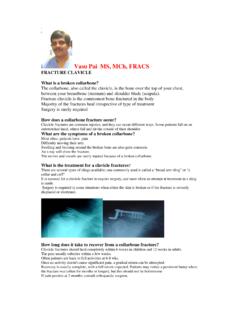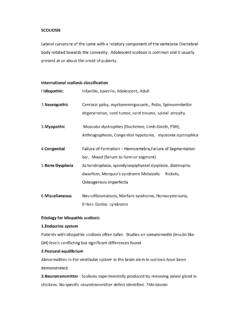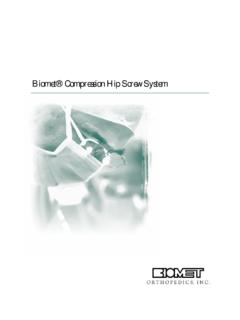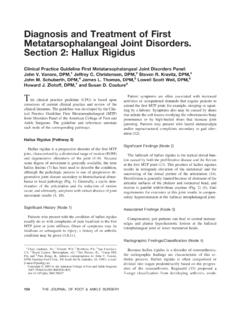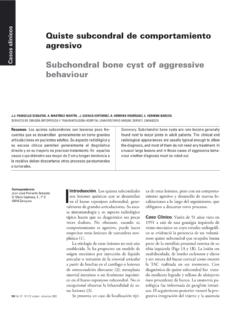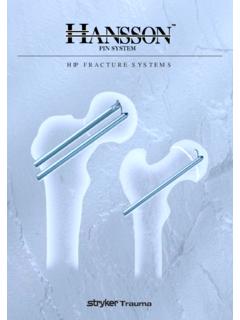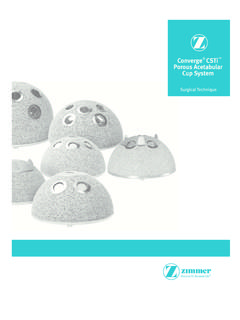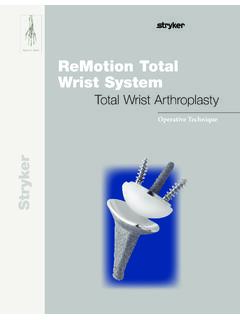Transcription of Painful Conditions of the Acromioclavicular Joint
1 Journal of the American Academy of Orthopaedic Surgeons176 The Acromioclavicular (AC) Joint isa relatively frequent source of clini-cal symptoms, most often due toprimary osteoarthritis, posttrau-matic arthritis, or distal clavicleosteolysis. These processes disruptthe normal anatomy and functionalbiomechanics of the AC Joint . Thisarticle will focus on the specifictechniques of evaluation necessaryto differentiate symptoms referableto the AC Joint from those relatedto pathologic changes in otherareas of the shoulder girdle, as wellas specific treatment strategies formanagement of Conditions involv-ing the AC Anatomy andBiomechanicsThe AC Joint is a diarthrodial Joint ,which supports the shoulder girdlethrough the clavicular strut.
2 Itconnects the oval, convex distalclavicle with the somewhat incon-gruous concave acromial the hyaline-cartilage artic-ular surfaces there is a fibrocarti-laginous meniscal disk of variableintegrity. Degeneration of the ACjoint is a natural consequence of theaging process, with disk degenera-tion occurring as early as the sec-ond early adulthood,most intra-articular disks are littlemore than fibrocartilaginous capsule surrounding thejoint has a synovial lining and isreinforced superiorly by the rela-tively thick superior AC ligament,and the confluent deltoid andtrapezius fasciae.
3 Inferiorly, thecoracoacromial ligament blendswith the less stout inferior AC liga-ment (Fig. 1). The AC ligamentcomplex reinforcing the Joint cap-sule plays an important role inmaintaining Joint capsular ligaments are predom-inantly responsible for maintainingstability in the anteroposterior (AP) ligaments also pro-vide most (68%) of the restraint tosuperior translation of the claviclewith small (physiologic) AC Joint complex isfurther supported by the conoidand trapezoid ligaments, which ex-tend from the coracoid to the under-surface of the clavicle. During largedisplacements, the conoid ligamentprovides the greater portion ofsuperior-inferior stability (62%).
4 The trapezoid serves as the primaryrestraint (75%) to compression ofthe AC the fact that the claviclerotates as much as 45 degreesabout its axis, almost all clavicularmotion takes place at the sterno-clavicular articulation. Motion atthe AC Joint is limited to 5 to 8 de-grees, predominantly because ofsynchronous scapuloclavicularmotion, in which the clavicle andscapula move as a Shaffer is Assistant Professor, Departmentof Orthopaedic Surgery, Georgetown Univer-sity Medical Center, Washington, requests: Dr. Shaffer, Department ofOrthopaedics, Georgetown University MedicalCenter, 3800 Reservoir Road NW, Washing-ton, DC 1999 by the American Academy ofOrthopaedic Acromioclavicular (AC) Joint may be affected by a number of pathologicprocesses, most commonly osteoarthritis, posttraumatic arthritis, and distalclavicle osteolysis.
5 The correct diagnosis of a problem can usually be deducedfrom a thorough history, physical examination, and radiologic AC Joint degeneration is frequent and does not always correlatewith the presence of symptoms. Selective lidocaine injection enhances diagnos-tic accuracy and may correlate with surgical outcome. Nonoperative treatmentis helpful for most patients, although those with osteolysis may have to modifytheir activities. In appropriately selected patients, open or arthroscopic distalclavicle resection is necessary to relieve symptoms. Recent biomechanical andclinical data emphasize the importance of capsular preservation and minimiza-tion of bone resection; however, the optimal amount of distal clavicle resectionremains elusive.
6 Patients with AC Joint instability have poor results after dis-tal clavicle Am Acad Orthop Surg 1999;7:176-188 Painful Conditions of the Acromioclavicular JointBenjamin S. Shaffer, MDBenjamin S. Shaffer, MDVol 7, No 3, May/June 1999177 Common Problems of theAcromioclavicular JointThe combination of three factorsunderlies the frequency of prob-lems of the AC Joint . First, becauseit is a diarthrodial Joint , it is vulner-able to the same processes affectingother joints in the body, such asdegenerative osteoarthritis, infec-tions, and inflammatory and crys-talline arthritis. Second, its superfi-cial location and its relationship tothe shoulder girdle predispose it totraumatic injury.
7 Third, the biome-chanics of the shoulder girdle re-quire the AC Joint to transmit largeloads across a very small surfacearea, which can result in failurewith repetitive activity or addition, the modern emphasison weight training and upper-extremity strengthening furtherstresses the AC Joint , which,according to Cahill,8is often theweak link in the shoulder OsteoarthritisIn comparison to the rate ofoccurrence in the knee and hip, pri-mary osteoarthritis in the shoulderis relatively , prima-ry involvement of the AC Joint ismuch more common than primaryinvolvement of the glenohumeraljoint and is, in fact, the most com-mon cause of pain in the AC true incidence is unknown, inpart because of differences in thecriteria used to define arthritis invarious studies.
8 Using morpholog-ic criteria, DePalma et al11demon-strated degenerative changes by thefourth decade in the majority of ACjoint specimens obtained from 151patients. In one study,1254% to 57%of elderly patients demonstratedradiographic evidence of degenera-tive arthritis. In another study,13magnetic resonance (MR) imagingdemonstrated evidence of arthriticchanges in 48% of the AC joints inover 300 older asymptomatic its seeming prevalenceby radiologic criteria, symptomaticprimary osteoarthritis is a relative-ly uncommon clinical of the AC Joint maybe associated with other shoulderdisorders and must be consideredwhen evaluating any shoulderproblem, especially rotator cuffimpingement.
9 The proximity of theAC Joint to the subacromial spacemay lead to clinical overlap in thesymptom ArthritisAcromioclavicular arthritis fol-lowing trauma is even more com-mon than primary osteoarthritis,due to the frequency of injury to thisvulnerable Joint . The incidence ofposttraumatic arthritis symptomsafter injury or surgery is highlyvariable and depends on the degreeof injury and the type of operativeprocedure. Studies of the naturalhistory of grade I and II sprains ofthe AC Joint have demonstrated thedevelopment of symptoms in 8% to42% of ,16 Arthritis alsooccurs, although less commonly,after distal clavicle fractures, partic-ularly those with Operative proceduresfor AC Joint dislocations in whichthe AC Joint is preserved or trans-fixed have been associated with ahigher incidence of arthritis thanthose in which the Joint is sacrificed( , Weaver-Dunn procedure).
10 Distal Clavicle OsteolysisAn increasingly recognized butstill infrequent entity that causesAC Joint symptoms is distal clavicleosteolysis. Osteolysis related torepetitive microtrauma has recentlybeen receiving more attention, par-ticularly among weight-lifting ath-CoracoacromialligamentAcromioclavicu larligamentsTrapezoid ligamentConoid ligamentFig. 1 The Acromioclavicular complex is composed of the Acromioclavicular ligamentsand the coracoclavicular ligaments (conoid and trapezoid). Painful Conditions of the Acromioclavicular JointJournal of the American Academy of Orthopaedic ,18 This condition is thoughtto be growing in frequency due tothe popularity of weight-trainingand its incorporation into fitnessprograms and training regimens forother sports.

